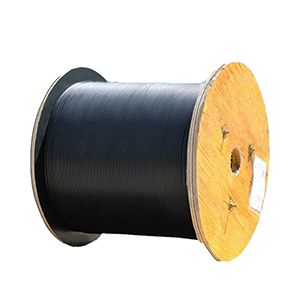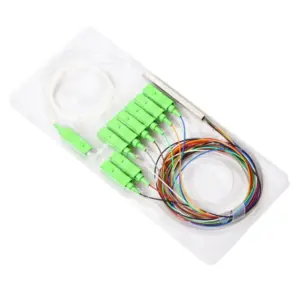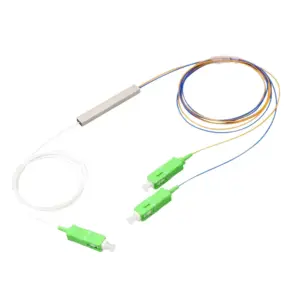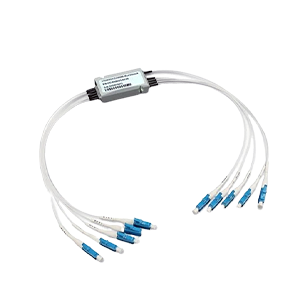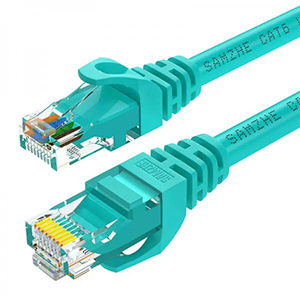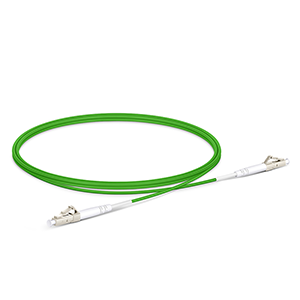Today, I will introduce to you OPGW optical fiber as a key technology for enhancing the communication capabilities of power transmission lines. We will explore the principles, structure and application advantages of OPGW optical fiber. As a revolutionary technology, OPGW optical fiber plays an important role in power transmission line communications. Let’s learn more about OPGW fiber optics together!
OPGW optical fiber overview
OPGW (Optical Ground Wire) fiber is a specially designed fiber optic cable used to simultaneously transmit optical signals and power signals on power transmission lines. The following is the basic knowledge about OPGW optical fiber:
Definition and working principle:
- OPGW optical fiber is a composite cable with optical fiber and metal wires, where the optical fiber is used to transmit optical signals and the metal wires are used to transmit power signals.
- The working principle of OPGW optical fiber is to transmit optical signals through the optical fiber core and transmit power signals on metal wires at the same time. The optical fiber and metal wires are independent of each other.
Structure and components:
- Fiber core: The fiber core in OPGW fiber is responsible for transmitting optical signals and usually consists of one or more optical fibers. Fiber optic cores typically consist of fiber optic cable cores that are carefully coated to provide protection and increased strength.
- Metal wires: Metal wires in OPGW optical fibers are used to transmit power signals and are usually made of aluminum or alloy. Metal wires provide power transmission and provide protection for the fiber optic core.
- Coating layer: The outside of OPGW optical fiber is a protective coating layer, usually composed of multiple layers of metal wires or composite materials. This layer of cladding provides protection and mechanical strength against damage from the external environment.
Transmission performance and technical indicators:
- Bandwidth: The bandwidth of OPGW optical fiber refers to the frequency range of optical fiber transmission, which determines its ability to transmit data.
- Loss: The loss of OPGW optical fiber refers to the degree of attenuation of optical signals during transmission. Low loss means that signals can maintain good transmission quality over longer distances.
- Tensile strength: The tensile strength of OPGW fiber refers to the maximum tension it can withstand, ensuring stable transmission performance under the tension of power transmission lines.
- Power performance: The power performance of OPGW optical fiber refers to the current and voltage it can withstand to ensure the transmission quality and safety of power signals.
The structure and performance design of OPGW optical fiber enable it to transmit optical signals and power signals simultaneously on power transmission lines, providing reliable communication capabilities and power transmission functions. This makes OPGW optical fiber widely used in the power industry for applications such as remote monitoring, communication and data transmission.
What are the advantages of OPGW optical fiber
OPGW (Optical Ground Wire) optical fiber has many advantages in power transmission line communications. The following is a discussion of these advantages:
-
Communication capabilities: OPGW optical fiber provides reliable communication capabilities, enabling applications such as remote monitoring, data transmission and communication on power transmission lines. Through optical fiber transmission, high-speed data transmission and remote communication can be achieved to meet the power system’s needs for real-time monitoring and communication.
-
Anti-electromagnetic interference: OPGW optical fiber has excellent anti-electromagnetic interference capabilities. Because its optical signals are transmitted in the fiber core, optical fiber is less sensitive to electromagnetic interference and can effectively resist electromagnetic interference from power transmission lines. This ensures the stability and reliability of communication signals.
-
High temperature resistance: OPGW optical fiber can work in high temperature environment, which is an important advantage in power transmission lines. Since power transmission lines may be affected by high temperatures, traditional communication cables may not be able to withstand working in high-temperature environments, while OPGW optical fibers can maintain stable performance and ensure communication continuity and reliability.
-
The importance of power network monitoring and communication: In modern power systems, real-time monitoring and communication are crucial to maintaining the safe and reliable operation of the power network. By deploying OPGW optical fiber on power transmission lines, remote monitoring, fault detection and communication functions of the power network can be realized. This can not only improve the reliability and safety of the power system, but also speed up fault diagnosis and recovery time, and improve the operating efficiency of the power system.
So OPGW optical fiber has obvious advantages in power transmission line communications. Its anti-electromagnetic interference and high temperature resistance allow it to work reliably in harsh environmental conditions, providing stable communication and monitoring capabilities. In terms of realizing power network monitoring and communication, the application of OPGW optical fiber is crucial to ensure the safe, reliable and efficient operation of the power system.
Overview of OPGW optical fiber application fields
OPGW (Optical Ground Wire) optical fiber is widely used in different types of power transmission lines. Here are some application cases:
-
Long-distance transmission lines: In long-distance transmission lines, such as across mountainous areas or submarine cables, OPGW optical fibers are widely used to implement communication and monitoring functions. By installing OPGW optical fibers on power towers, remote monitoring, fault detection and communication functions of power lines can be realized, improving the reliability of the power system and the efficiency of fault diagnosis.
-
High-voltage transmission lines: In high-voltage transmission lines, such as 500kV, 750kV or even higher voltage lines, the application of OPGW optical fiber is particularly important. These high-voltage lines often have large electromagnetic interference and high-temperature environments. OPGW optical fiber has the characteristics of anti-electromagnetic interference and high-temperature resistance, and can work reliably in such harsh conditions to provide communication and monitoring functions.
-
Smart grid: With the development of smart grid, OPGW optical fiber plays an important role in realizing the monitoring and communication of smart grid. By deploying OPGW optical fiber on power transmission lines, real-time monitoring, data transmission and communication of power grid equipment can be achieved, thereby achieving intelligent management and optimized operation of the power system.
-
Wind farms and solar power stations: In renewable energy projects such as wind farms and solar power stations, OPGW fiber optics are used to enable communication and monitoring of power transmission lines. These projects often require remote monitoring and data transmission to ensure the reliability and efficiency of power production. By installing OPGW optical fiber on power transmission lines, remote monitoring, fault detection and communication of the power system can be achieved.
To sum up, OPGW optical fiber is widely used in different types of power transmission lines. Its application is particularly important in long-distance and high-voltage transmission lines, where it can provide reliable communication and monitoring functions. In addition, OPGW optical fiber is also widely used in smart grids, wind farms, solar power stations and other fields to achieve remote monitoring and data transmission of power systems.
OPGW optical fiber deployment and maintenance
Deploying and maintaining OPGW (Optical Ground Wire) optical fiber requires following some key steps and points. The following is a discussion of related content:
Key steps and points for deploying OPGW fiber:
-
Planning and design: Adequate planning and design are required before deploying OPGW optical fiber. This includes determining the number of fibers, length of the line, installation location and connection points, etc. At the same time, the characteristics of power transmission lines, environmental conditions, and communication and monitoring needs need to be considered.
-
Security considerations: Security is crucial when deploying OPGW optical fiber. Ensure staff have relevant safety training and equipment and follow safe operating procedures. Especially when working near high-voltage lines, electrical safety standards and operating procedures must be followed.
-
Optical cable installation: OPGW optical fiber installation is usually performed on existing power transmission lines. Fiber optic cables need to be fixed to the power tower and connected to the ground system. Ensure that the optical cable is installed securely to avoid damage from external physical forces.
-
Optical cable connection: The connection of OPGW optical fiber requires the use of professional optical fiber connection technology, such as mechanical connection or splicing. The quality of the connection points is crucial to the transmission performance of the optical fiber, so it is necessary to ensure the accuracy, stability and low loss of the connection points.
The importance of regular inspection and maintenance of OPGW fiber:
-
Regular Inspections: It is important to regularly check the condition of fiber optic cables and connection points. Inspections should include visual inspection and fiber optic performance testing. By checking whether the appearance of the optical cable is intact, whether the connection point is stable, and whether the optical fiber transmission performance is normal, potential problems can be discovered in time and measures can be taken to repair them.
-
Cleaning and Protection: Keeping fiber optic cables clean and protected is key to maintaining fiber optic performance. Regularly clean the dirt and dust on the surface of the fiber optic cable and ensure the sealing of the connection points. In addition, protective measures can be taken, such as the use of protective sleeves and sheaths, to prevent optical cables from being damaged by external physical or environmental factors.
-
Troubleshooting and repair: If problems with fiber optic connections or transmission performance are found, troubleshooting and repair should be carried out in a timely manner. This may involve re-splicing the connection point or replacing damaged fiber. Rapid response and repair can reduce the length of communications outages and ensure continuous operation of the power system.
So deploying and maintaining OPGW optical fiber requires following a series of key steps and points. Regular inspection, maintenance of cleanliness and protection, timely troubleshooting and repair are important measures to maintain the performance of optical fiber and ensure the operation of the power system.
Summary
Thank you for reading our blog! Through the discussion in this article, you will have a deeper understanding of OPGW optical fiber as a key technology for enhancing the communication capabilities of power transmission lines. OPGW optical fiber has great advantages in power transmission line communications due to its anti-electromagnetic interference and high temperature resistance properties. By choosing our OPGW fiber optic products, you will receive a solution of high quality, reliability and performance.
OPGW Fiber FAQ
The primary purpose of OPGW fiber is to provide a reliable and secure means of communication for data transmission and monitoring along power transmission lines. It enables real-time monitoring, control, and protection of the power grid.
OPGW fiber consists of a central metallic core surrounded by layers of optical fibers and protective materials. The metallic core provides mechanical strength and electrical conductivity, while the optical fibers transmit data signals.
Using OPGW fiber offers several advantages, including enhanced grid reliability, improved communication capabilities, reduced maintenance costs, increased resistance to lightning strikes, and minimized electromagnetic interference.
OPGW cables typically use single-mode optical fibers due to their longer transmission distances and higher bandwidth capacity. These fibers are designed to meet the specific requirements of power transmission line applications.
OPGW fiber is installed during the construction or retrofitting of power transmission lines. It is integrated into the design of the ground wire, which is then strung along the transmission towers using specialized installation techniques.
Yes, OPGW fiber serves a dual role. It functions as both the grounding wire for electrical protection and the communication medium for transmitting data signals, enabling simultaneous power transmission and communication.
OPGW fiber is commonly used in high-voltage power transmission lines, such as those used for long-distance transmission and grid interconnections. It is also utilized in critical infrastructure projects, such as smart grids and renewable energy installations.
OPGW fiber incorporates conductive materials in its design, which helps to divert lightning strikes and protect the power transmission line from potential damage. The metallic core provides a path for the lightning current to safely dissipate into the ground.
In the event of fiber damage, OPGW fiber can be repaired or spliced using standard fiber optic repair techniques. However, proper expertise and specialized equipment are required to ensure the integrity and performance of the repaired section.

